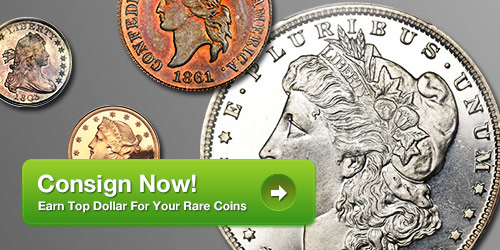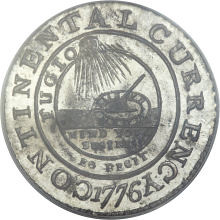
PREV ARTICLE
NEXT ARTICLE
FULL ISSUE
PREV FULL ISSUE
MORE ON THE 1776 CONTINENTAL CURRENCY COINAGELast week Andrea Grimason shared a summary of her theory on the creation of the continental currency coins. In summary, she believes that:
John L. (Jack) Howes writes I expect you may get quite a few comments about this theory. Hard to decide where to start. I guess my main problem is that there are a number of factual errors:
1) The Soho mint did not exist in 1775 (not created until 1788),
Dick Doty concurs with the first point. He writes: A slight difficulty with the latest Continental Dollar explanation: the Soho Mint wasn't begun until 1788, didn't strike its first money till the late summer of the following year. Andrea Grimason responds: Boulton was active before 1788. He had been making medals and coin weights since 1775. The original coins were made on Boulton's property in Soho, but they were not made on the new machines at the mint - they were hand made. Jack writes: I would like to see a good quality image of this silver coated copper specimen. Does such an image exist? If the image does not rule the coin out immediately, I am sure I can find someone to do a surface XRF analysis. Jack also provided some great background information from Heritage lot descriptions. Here's a nice summary of Eric Newman's theory of the origin of these pieces:
"There is no doubt that all of the varieties of the coinage were made by the same diemaker, and it is fortunate that the initials EG were placed on one variety (3-C). "There was no other avenue of research than to begin by looking for a qualified person with those initials. It was a pleasant surprise, therefore, to find that in 1776 there lived an American engraver by the name of Elisha Gallaudet. Merely naming him without supporting data would satisfy no one even though no other qualified person with the initials E.G. could be found. Thus, research to prove or disprove that theory was undertaken." At the end of his 12-page article providing substantive evidence, Newman summarized the facts that related to his conclusion that "EG" was Elisha Gallaudet. The following were his points:
1. Elisha Gallaudet was the only engraver with initials E.G. in 1776.
http://coins.ha.com/c/item.zx?saleNo=1173&lotNo=5006
My earlier question relates to point 5 and 6. I don't know if I've seen any work known to be from the hand of Elisha Gallaudet, but the Continental Currency coins do not look to me like the work of Boulton.
-Editor
Table of rarity of die varieties and different metals:
Hodder Newman Composition Rarity Comments
1-A.1 1-A Brass Three known Bowers reversed the rarity of this and the next
http://coins.ha.com/c/item.zx?saleNo=1173&lotNo=5006 Jack writes: The minting sequence of these has been determined. This is from Heritage (not sure who wrote it but I checked this order from the images I have collected (about 100) and concur):
Continental Dollar Die States and Production Order Among many numismatic pleasantries is the determination of the order that a series of coins were produced, commonly called the emission sequence. For the Continental Currency coinage, several observations will assist the study. We know that just two reverse dies were used for the entire series with a convenient break that provides two distinct groups. Reverse A exists in three stages, so we can be certain that the varieties were struck in order as 1-A.1, 1-A.2, and 1-A.3. The obverse of 1-A.3 exists in a number of die states, so that sequence can be further fine tuned. The development of rust marks on the reverse of variety 2-A.3 informs us that it was the last variety produced with the first reverse die. The second reverse was used to produce three varieties from two obverse dies. This reverse has a prominent die crack curving through many of the rings, and stages of the crack help us determine the striking order. On variety 3-B, the crack begins in ring 13 (Georgia) and continues clockwise through eight additional rings, terminating in the Delaware ring. Two examples variety 3-B in the present sale are entirely different die stages. The PCGS MS64 example is in the die stage just described, while the MS63 NGC piece is a much earlier die stage with an intermittent crack that misses some of the rings. The Ornamented Date coin, variety 4.1-B, is in a similar stage with the earlier state of 3-B. Michael Hodder studied the die states extensively, and determined the emission sequence of the second group as 3-B, 4-B, 3-B, 4.1-B, and 3-B. A further complication in the development of an emission sequence is where to put the off metal brass and silver pieces. The brass pieces were struck before and simultaneously with the pewter coins. The silver pieces from Reverse A were coined between intermediate and late states of 1-A.3, and the silver pieces of Reverse B were coined simultaneously with the first pewter examples of variety 3-B. The two groups of varieties are unconnected, meaning there is no single obverse die that was used with both reverse dies. Hodder pointed out that there is no common punch used on both reverse dies. However, the geographical relationship of the rings on the blundered Reverse A, and the corrected Reverse B almost ensures that Reverse A was used first. The emission sequence of the Continental Currency coinage follows closely the sequence that Hodder presented in his 1991 article.
Group One - Reverse A
Group Two - Reverse B
http://coins.ha.com/c/item.zx?saleNo=1128&lotNo=1006 To read the earlier E-Sylum article, see: GRIMASON'S THEORY ON THE 1776 CONTINENTAL CURRENCY COINAGE (www.coinbooks.org/esylum_v15n48a11.html)

Wayne Homren, Editor The Numismatic Bibliomania Society is a non-profit organization promoting numismatic literature. See our web site at coinbooks.org. To submit items for publication in The E-Sylum, write to the Editor at this address: whomren@gmail.com To subscribe go to: https://my.binhost.com/lists/listinfo/esylum All Rights Reserved. NBS Home Page Contact the NBS webmaster 
|
